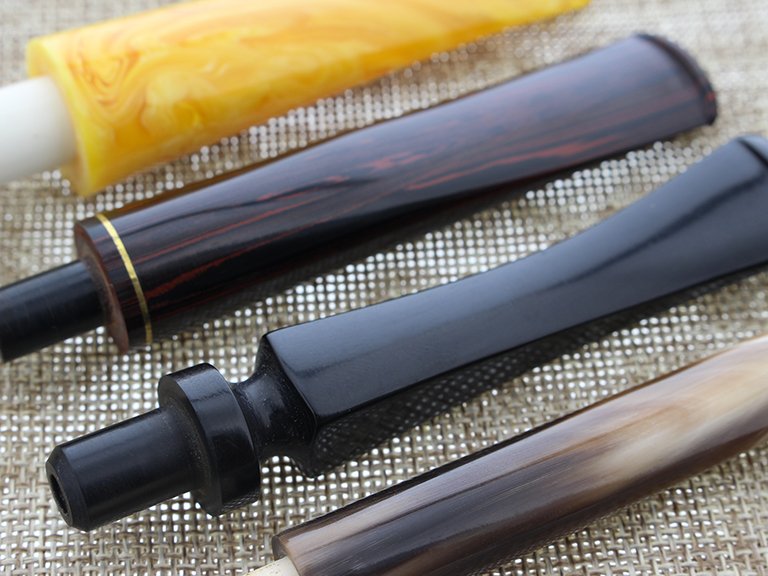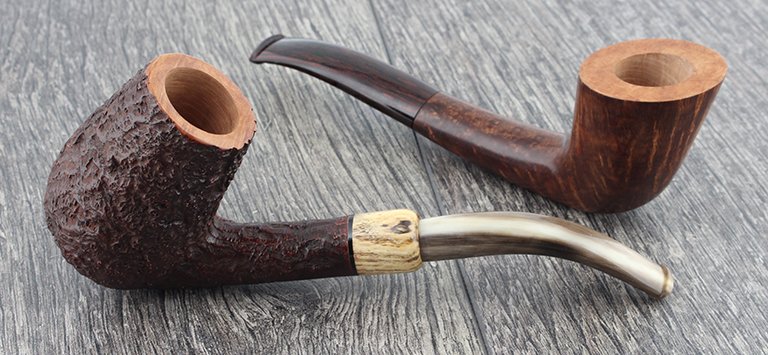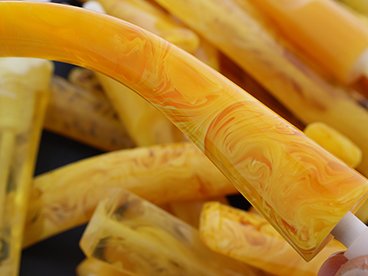
A pipe stem can be made from different materials. Each material has its pros and cons, whether in terms of feeling or aesthetic. Maintaining a pipe stem in perfect condition requires a little bit more than it looks. A clean stem is the insurance of a pleasant pipe to smoke. If you therefore have inherited from your grandpa's pipe or if your pipes are quite worn out, our recommendations will allow you to bring back brilliance and shine to your pipe stems.
Acrylic bars used for the manufacturing of stems
Which material is my pipe stem made of?
Before we tell you about the cleaning of your pipe stem, it is important to understand the materials used for making a stem. Nowadays, pipe manufacturers usually use ebonite, acrylic or cumberland. These are the three predominant materials on the market for making pipe stems.

Why and how to choose a pipe stem? Here is everything you need to know:
Ebonite:
Ebonite has always been the most widely used material for the manufacturing of stems. There is actually a reason for this: its softness. The contact under the tooth is pleasant because the material is relatively malleable. As a result, on an ebonite stem, tooth marks will not be rare. By keeping the pipe in mouth and slightly biting the stem to keep it in mouth, tooth marks will naturally appear. Smokers appreciate comfort provided by ebonite when in the mouth, and it is the reason why they tend to choose this material. Moreover, ebonite is most of the time less expensive than acrylic (even though it depends on quality).
At first glance, it may not be easy to differentiate between an acrylic stem and an ebonite stem. Ebonite allows more finesse. The mouthpiece can therefore be thinner and its general silhouette more tapered. At Dunhill, for example, most of the stems are made from ebonite.
Claire, La Pipe Rit

Natural bent Saint-Claude pipe (short ebonite stem)
Ebonite's manufacturing process is called "vulcanization", which is why we also sometimes find the word "vulcanite" when talking about ebonite. You have to know that ebonite contains rubber and sulfur. Over time, ebonite has the disadvantage to wear out and turn yellow (oxidizes). It is therefore essential to regularly clean your stem to keep it fit to be used. We will be tackling on this matter in a subsequent paragraph to give you all our tips.
The French pipe maker Bruno Nuttens mainly uses ebonite that comes from Germany. It is indeed in Germany that high-end ebonite is made. Being better quality, this ebonite will withstand even better the test of time. Nutten's stems are actually entirely handmade from a complete ebonite bar.
Claire, La Pipe Rit
Acrylic:
Acrylic is a very resistant material. It is therefore harder under the tooth, a little less comfortable than ebonite, but it has the big advantage of being more durable over time. Unlike ebonite, acrylic does not tarnish, and keeps its brilliance and its radiance much longer. (Be careful though, this does not mean that you do not have to maintain your acrylic stems!). The hardness of acrylic can therefore be a barrier to some smokers, but an advantage for others (because there is less maintaining to do). Acrylic is quite difficult to work for craftsmen pipe makers because its cutting is very delicate and precise.
The German manufacturer Vauen only uses acrylic for its pipe stems. All Vauen pipes have an acrylic stem and are equipped with a 9mm active charcoal filter (the famous "Dr Perl Junior" also developed by the brand).
Jean, La Pipe Rit

Savinelli Fantasia pipes (colored acrylic stems)
In life, not everything is one or the other. Actually, acrylic opens a range of possibilities regarding colors (orange, green, blue... but also black). As a result, manufacturers can imagine whatever they want: a black sandblasted briar with a white/cream colored acrylic stem, or a laquered colored briar coupled with a cloudy stem... Well, a little bit of fantasy to give some style and match everyone's taste. Having a colored stem can completely change a pipe, even on a classical straight model.

For information, we also sometimes find the word "lucite" when talking about acrylic. It is actually a variety of acrylic.
Bastien, La Pipe Rit
Cumberland:
Cumberland has a composition very close to that of ebonite. It therefore has the same characteristics: suppleness, comfort, and an easy-to-do maintaining. Cumberland stems can be recognized by their color, and they usually have a marbled pattern (black and brown colors). Less common than ebonite or acrylic, cumberland will most of the time be found on high-end pipes or unique models. Pierre Morel, a French pipe master from Saint-Claude, often uses cumberland for his creations. This very attractive material perfectly matches with very flamed briars because its aspect reminds of the grain of the wood.
Did you know that at Dunhill ("The White Spot"), there is a pipe series called "Cumberland". All the pipes of this series, as the name suggests, are equipped with a cumberland stem. Dunhill Cumberland pipes are very nice because the whole is harmonious and the difference between the head of the pipe and its stem is less noticeable.
Claire, La Pipe Rit

Pierre Morel pipes (cumberland and horn stems)
Are there any other materials for stems?
We previously spoke about ebonite, acrylic or cumberland, but these are not the only materials used when manufacturing pipe stems. You will also find horn stems (the Amorelli Dandy series is equipped with stems that combine horn and acrylic), beech wood stems (for the Vauen The Shire pipes for example), methacrylate stems (used by Mimmo Provenzano), or even bamboo stems (for Rostiak's "Mushroom" pipes).
Meerschaum pipes used to be made with genuine amber. Nowadays, this is no longer the case because shards of genuine amber are very rare (and difficult to make). Acrylic stems of a very similar color to amber are therefore used.
On www.pipeshop-saintclaude.com, we always indicate the stem's material for each pipe we propose. It is a very important criterion to take into account before buying a pipe. Obviously, we also indicate which type of filter can be used with a pipe, because some smokers will prefer a pipe with 9mm filters, whereas others will smoke without any filter at all.
Bastien, La Pipe Rit
The maintenance of a pipe stem:
When talking about the maintenance of the stem, there are two things to take into account: interior maintenance and exterior maintenance.
Interior maintenance:
First, you must clean the stem's conduit. You have to get rid of tar and humidity after each time you have smoked. It is our basic recommendation so that you can fully enjoy your pipe, prevent it from getting clogged, and save yourself from an unpleasant taste when smoking. By leaving old residues inside, you will lose the real flavors of your tobacco. To start with, you will need pipe cleaners. There are different kinds of them, more or less "scratching", and more or less long (depending on the length of your stem). For perfect cleaning, we often recommend:
- rigid pipe cleaners that will do most of the work. Use them from time to time (periodicity will depend on the size of the bowl of your pipe and the tobacco you smoke, some of the latter fouling a pipe more or less). Here is for example a pack of 100 pipe cleaners that are perfect to deeply clean your pipe stem.
- softer pipe cleaners to use on a daily basis every time you have finished smoking. Be careful though, and let your pipe rest and completely cool down before disassembling it. A pack of 80 pipe cleaners of the brand Vauen will suit every pipe because these pipe cleaners are thin and of a conical shape.
Now that you have the right tools, you can start cleaning your pipe. You kind of have to sweep the inside of the stem with a pipe cleaner. For that, insert the pipe cleaner inside the stem, doing back and forth movements. The pipe cleaner comes out dirty? Get another one and repeat again until the inside of your stem is clean. Regardless of the material of the stem, the method is the same! You may have to be more careful with P-lip stems and eventually with stems with a double piercing.
For the best cleaning possible, you can combine pipe cleaners with a cleaning liquid specifically designed for stem cleaning. Just dip the pipe cleaner in the flask, and put the pipe cleaner in the stem, proceeding as described above. The result will even be better!
Bastien, La Pipe Rit
Exterior maintenance:
Now that the inside of your stem is clean, let's clean the outside. Depending on the material your stem is made of, you will have to be more or less careful. Ebonite is the material that requires most maintenance. To clean your stem, there is nothing better than a special wax designed for stems. Here is a video that explains it all:
Each smoker has their own techniques or secret recipes to clean their pipes... Toothpaste, salt, alcohol, olive oil, bleach, averyone goes for their own experiments. However, be careful of the results, you have been warned!
Jean, La Pipe Rit
An ebonite stem in perfect condition?
How to prevent your ebonite stem from being damaged too soon? Here are a few rules to follow:
- Do not leave your pipe in direct contact with the sun (for too long). Ultraviolet (UV) rays will accentuate the aging of your stem. The sun, heat source, will accelerate oxidation of ebonite and bring out sulfur. As a result, the stem will prematurely turn yellow and will lose its brilliance. Exposing your pipe to the sun for a whole afternoon on your car dashboard or putting it on the windowsill are not good ideas.
- Regularly clean the stem. The more regularly you clean it, the easier the cleaning will be. If you wait for it turning yellow, bringing it back to its original state will be even more difficult. At least take the habit of vigorously rubbing it with a soft piece of cloth. Saliva's acidity will also promote oxidation. Take care of your pipe stems!
- Use products designed for the cleaning of your pipe. Some products do not mix well with your pipe stem. Choose products specifically made for it. Wax to apply on the stem and cleaning liquid for the inside. These products are almost magical, why try to do without?
As a last resort, change the stem of your pipe! In some cases, it is almost impossible to bring it back to its original state. Tooth marks, the color that has completely changed or even worse: the mouthpiece broke. There is no other solution than changing it. At La Pipe Rit, we do the repairs directly in Saint-Claude. For more information, you can refer to the "Pipe repairs" webpage, or more simply e-mail us!
Share this article to your favorite social networks!
-
 Advice
Advice Restoring radiance to the briar, making the disassembling of your pipe's stem easier... Here are all our tips to [...]







